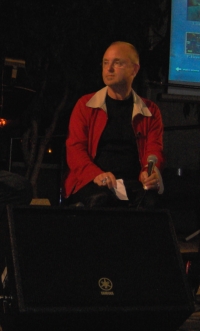It’s funny how our own personal preferences can make it so difficult to review concerts objectively. Take Monday night’s American Composer’s Orchestra concert, at Zankel Hall in New York – all seven pieces were good, often impressive, sometimes subtle and complex. But the things I want to rave about were not, I suspect, the things that most of the audience would have raved about when they got home.
Min Xiao-Fen’s Blue Pipa, for voice and the lute-like Chinese instrument named in the title, opened the concert effectively. Min performed the piece herself in a pool of light on an otherwise dark stage, and the combined vocal acrobatics and impressively virtuosic pipa playing made for a lovely and exciting piece. One audience member told me during intermission that it could have gone on for another five minutes and still been exciting.
Tania León’s Indigena combined the Cuban carnival music of her youth with quasi-tonal modernism in her trademark style. Her great skill lies in making this marriage organic—not so much seamless as deeply integrated, and never condescending to either tradition.
Speaking of integrative skill, Harold Meltzer’s Virginal performed the same feat with Renaissance stylings in a similarly modernist, quasi-tonal context. The contrapuntal music felt deliberate and rigorous in the same way that a 17th century fugue or an early 20th century serialist piece does.
But for all their virtues, and in spite of how well the audience liked them, none of the first three pieces excited me in the way that two sections of Vijay Iyer’s Interventions did. Perhaps a third of the way in, the orchestra drops out and Iyer, who was playing the largely improvised piano part, lets loose with a set of rippling riffs while pre-processed drum and hi-hat loops bounce back and forth in the speakers. I’m not convinced that the section really fit with the rest of the piece, but I have difficulty really minding. The piece’s long, static denouement was, for me, the heart of the piece. Most of the orchestra starts snapping their fingers in a steady slow rhythm, while the piano and strings give a long, droning, steady chord. It’s funny at first—you expect them to break into “boy, boy, crazy boy”–but as it continues the snaps reclaim their independence and provide an unusual sounding grid while the percussionist plays a slow pattern on a suspended cymbal. The cymbal patter sounds regular, but out of sync with the snaps, but if it was truly regular I couldn’t figure out the pattern. The overall effect was gorgeous and entrancing, and I didn’t want it to stop.
After intermission, Andrew McKenna Lee played his solo guitar piece Arabescata, which weaves together rock and classical language. It worked very well as a compliment to Blue Pipa from the first half—again sometimes pretty and sometimes impressively virtuosic. Kurt Rohde’s White Boy/Man Invisible was the least memorable segment of the concert for me, but as I recall the audience response was one of the most enthusiastic of the evening.
Rounding out the theme of integration of different musics, Steven Mackey played guitar for his Deal, a concerto of sorts for electric guitar and orchestra. Much of the first half of the piece didn’t engage me, although Mackey did a remarkably skillful job of combining the guitar with the orchestra in an organic way. As with Vijay Iyer’s piece, however, the final sections made the whole concert worthwhile. Most of the orchestra drops out, and Mackey sets up some looping grooves with his effects pedals against, surprisingly enough, recordings of what sounded to me like chickens, playing slowly evolving chords and countermelodies over it, building gradually over several minutes. By the time the orchestra came back, I was sold, but again it was some of the least spectacular music that did it. Maybe I just like the wrong things.

 New York, NY, March 29, 2007. I’ve been a fan of Evan Ziporyn’s music since six or seven years ago when I first heard his work in a concert of piano music at Dartmouth College. (I think it must have been “Pondok,” in a recital by the fabulous Sarah Cahill, but I can’t seem to find evidence to support that conclusion. Sarah, if you’re out there. . .) Ziporyn is a fixture at Bang On A Can, and a member of the Bang On A Can All Stars where he plays a mean clarinet; he’s also a member of the music faculty at MIT and the founder of Gamelan Galak Tika. Last Thursday, Ziporyn teamed up with cello-percussion duo Odd Appetite (Ha Yang Kim and Nathan Davis) and bassist Robert Black (another Bang On A Can All Stars member) for two sets at The Stone, John Zorn’s Alphabet City new music dive.
New York, NY, March 29, 2007. I’ve been a fan of Evan Ziporyn’s music since six or seven years ago when I first heard his work in a concert of piano music at Dartmouth College. (I think it must have been “Pondok,” in a recital by the fabulous Sarah Cahill, but I can’t seem to find evidence to support that conclusion. Sarah, if you’re out there. . .) Ziporyn is a fixture at Bang On A Can, and a member of the Bang On A Can All Stars where he plays a mean clarinet; he’s also a member of the music faculty at MIT and the founder of Gamelan Galak Tika. Last Thursday, Ziporyn teamed up with cello-percussion duo Odd Appetite (Ha Yang Kim and Nathan Davis) and bassist Robert Black (another Bang On A Can All Stars member) for two sets at The Stone, John Zorn’s Alphabet City new music dive.